
A Process for Gamifying a College Course
If you’re like me, you’re probably convinced gamification holds real value for teachers in higher education. But among the many inspirational case studies of individual games or game mechanics, I haven’t been able to find a clear step by step process for gamifying an entire college-level course. The theory and anecdotes are great at showing me ‘why’ and ‘what’ can be done, but I’ve yet to stumble on something that shows me ‘how’.
In this ‘poster session’ I’ve documented the steps I took in creating a gamified course from scratch. Starting with a list of desired learning outcomes and ending with themed projects built around a story, with a point system, levels, badges, and tips on how to keep the administration of the game organized.
Gamification
mechanics used
With a plethora of game mechanics to choose from it's impossible to account for all of them in one class.
So I chose the following 6 to implement in my class.

Small Games
These are bits of interactivity that can be inserted into any existing lecture class to reinforce the spoken material and break up the monotony of students sitting and listening for over an hour.

Badges
These are themed rewards given when students complete a certain kind of
side quest or task.

Long games
These last an entire class period. They require the most effort to implement but can have the biggest ROI when it comes to building community among the students and reinforcing course content.

XP & Levels
This creates a secondary currency in the class aside from the grade to motivate student engagement with the course material.

Side quests
These are optional tasks offered to students to give them more opportunities to explore the subject area of the class.

Storylines
Giving your entire course a narrative structure, where your students play through the course material as characters within a
fictitious setting.


Setup
01
List learning outcomes
Every course development process should start with clarifying what you want students to get out of the class, and a gamified class is no different. It’s important to make sure the fun and games is grounded in real learning and not a distraction from it. If you’re converting an existing class then this step should be easy, but it can’t hurt going over this list again to make sure this list is as lean but comprehensive as possible given the length of the semester. Start a spreadsheet with this list in the left-most column, as this will come in handy later. This is a look at how my list looked at the end of this stage.
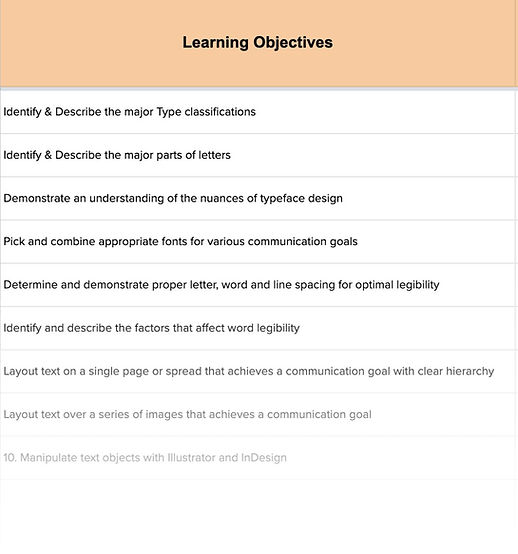
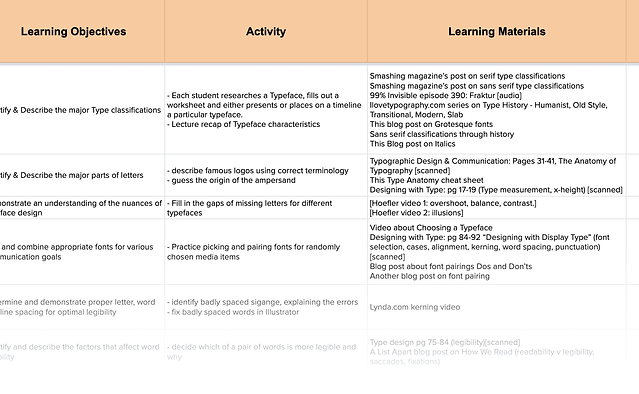
02
Choose relevant teaching resources & activities
In the columns to the right of each learning outcome, list the teaching resources you have planned for each of them. Lectures, activities, videos, reading materials, and anything else related to the topic should be listed in these columns. If you’ve created a lesson plan before then all this should be familiar. If you’re like me and was only introduced to this brilliance recently, then welcome to your saner life. It’s a great way to keep your brain organized as you plan your course, but also to categorize and store any new materials you come across in the future.

Brainstorm:
As you organize your materials and planned teaching methods, think about ways to insert activities into your lectures, and how you could turn those activities into games.

Berkeley’s Center for Teaching & Learning has a great starter list of ideas for active learning techniques


Rob Plevin’s “Active Learning Toolkit” and “Fun Teacher’s Toolkit” also provide a treasure trove of ideas to activate classes.
03
Decide on assessment methods
Add another column to the Lesson Plan spreadsheet to house how you’re going to assess how well your students are learning. Since I teach Typography, my assessments are in form of visual projects students complete to show they’ve grasped the principles we cover in class. For more theory-based classes these might be quizzes or papers.
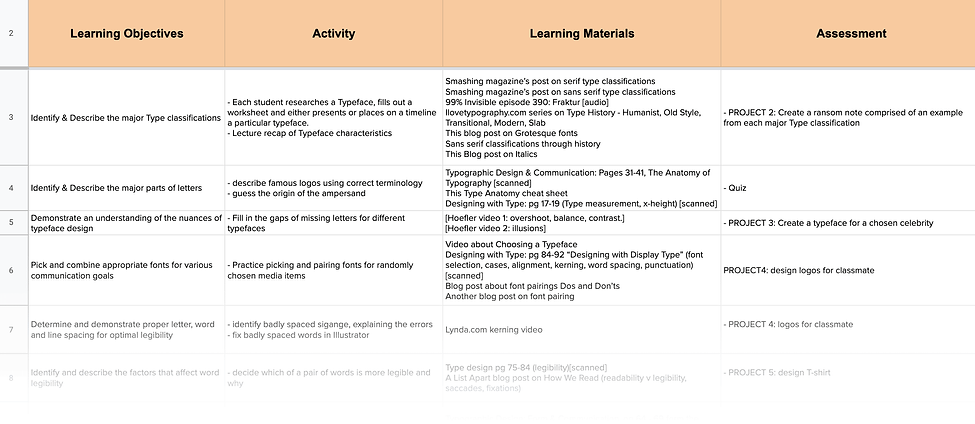


Coming up with fantasy scenarios for a class might seem over-indulgent, but I was surprised by the positive feedback my students gave in response to their projects having a theme.
If you'd like to learn more on how storylines can be beneficial to a class, check out:


04
Create storylines/ themes
Although optional, this could be a fun way to stretch your creative muscles and give your gamified class a unique setting. It could be as realistic as assuming the role of a professional in whatever field your students are studying, or as far-fetched as unreal fantasy lands. The important aspects here are to identify:
-
a setting
-
a role for your students to play as, and
-
a goal they need to work towards.
For example, I settled on two options for my class, Crime investigators where students play as recruits who need to earn their way on to an elite Type crime-fighting agency (ala the FBI) and fantasy guild members competing for dominance in the kingdom of Typographia (ala Dungeons & Dragons).


My students got to choose which "storyline" they will play over the course of the semester.
Michael Matera’s eXPlore like a Pirate (which heavily informed this part of my class) has more ideas on possible themes.

05
Craft the rationale for each activity & project within the world of the theme
Like any good story, you need to do some world-building. So it’s time to head back to the Lesson Plan spreadsheet and add another column for the theme(s) you’ve chosen, or are playing with for now if you haven’t settled on one yet. I like giving the themes an appropriate title. So the FBI theme I called Type Squad and the D&D storyline, I called Game of Guilds. {If you want to go overboard as I did You can create branding for each theme as well).
The theme then dictates the nomenclature you use throughout the class. So in Type Squad, my assessment projects become cases, classroom activities become basic training. If you’re implementing levels those would be called ranks (you get the idea). Have fun thinking of alternate names for class activities and resources to help make the world as real as possible.
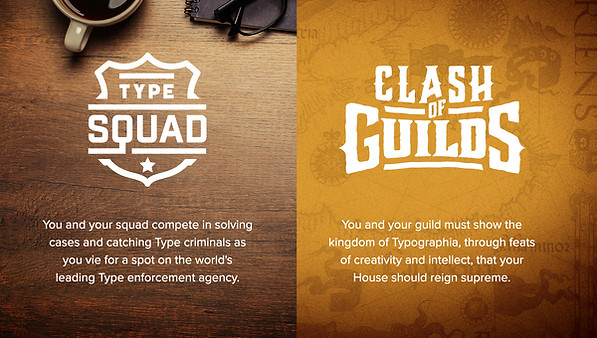
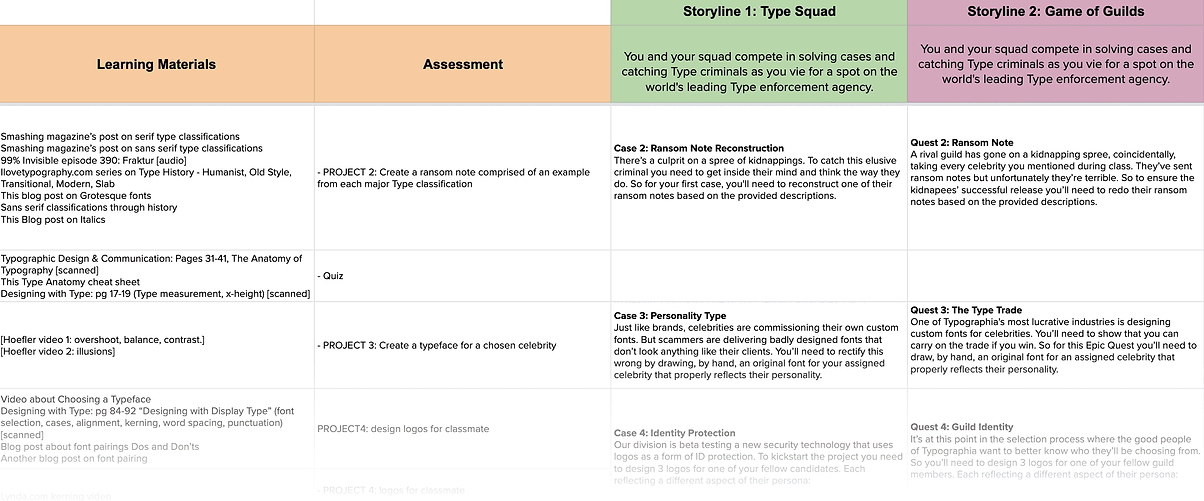
Then write down rationales for each assessment project to fit within this world you’ve created. I stuck to just theming the projects, but if you’re willing, and have the time, you could write a backstory for each and every class activity.
For example, one of my projects involves collecting samples of different typefaces, so the Type Squad rationale was to task the recruits with recreating ransom notes to secure the release of their chosen celebrity. Another project involved designing an image to show they understood the principles of visual hierarchy. So the Game of Guilds rationale tasked them with picking their favorite artist, then designing an artifact to nominate them as patron saint.

Ransom Note by
Abigail Souvannaphandhu

Ransom note by
Anna Connelly


Patron Saint layout by
Krysti Muccia
Patron Saint layout by
Anastasia Caron


As you can see my current list of XP-earning tasks is short.
06
Decide how they can earn currency
Taking a step away from the storylines for a moment, it’s time to start on the gamification mechanics. These are the various tactics you’ll employ to help motivate your students and keep them engaged with the course material. Something Karl Kapp in his book The Gamification of Instruction and Learning FieldBook, calls Structural Gamification as it pertains to the structure of the incentives, not their content.
This starts with identifying ways in which students can earn valuable, grade-independent, currency in the class. These are the actions and behaviors you want to encourage in your students but can’t, or don't want to, tie to a grade. They aren’t necessarily content-specific skills that line up with your learning outcomes, but behaviors that help your students get the most out of your class. E.g.
-
Showing up to class on time,
-
Turning in assignments on time,
-
Helping other classmates,
-
Contributing to class discussions,
-
Accomplishing bonus tasks (called Side quests in video games) that offer students a chance at more practice in certain areas,
-
Doing the assigned reading
07
Give the currency some value
Now that you have a list of ungraded tasks you want students to attempt, it’s time to give them some value. Create a separate list of all the perks you’re willing to offer. Don’t worry about point allocations quite yet, just list all the things you think students would find valuable aside from a grade.
For my class I’ve included:
-
The ability to resubmit projects
-
A limited number of additional excused absences ( consult your faculty handbook to see what’s allowed)
-
Get a helpful clue during a class puzzle or game,
-
Extending a deadline for a project
-
The ability to retake the Quiz
-
Earn Badges - groups of tasks or side quests could be themed around accomplishing a particular badge e.g. Type Gamer, Film Buff, History buff.
Leveling up
If you’re offering levels then strategize how the perks will accumulate as they ascend the ladder. Put the most desirable perks near the higher levels as an incentive.

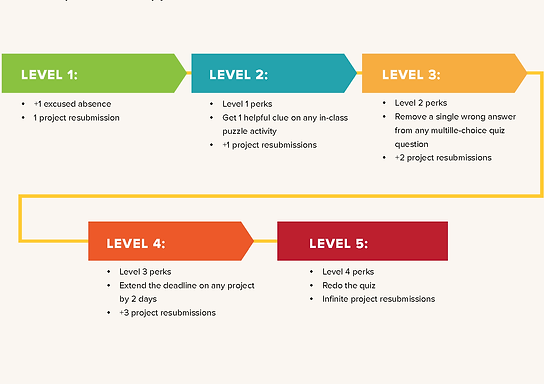
Above: a chart showing the 5 levels possible in my class with their corresponding perks.
Below: the 6 badges students can earn by successfully completing side quests.



After adding up all the possible points, I made a judgment call about how many points I would require for each level. No math, just a gut feeling.
08
Decide on the point system
Now it’s time figure out how many points (typically called XP for experience points) each behavior earns and how much each perk, or level, costs.
-
Start by prioritizing the list of behaviors from Step 6 based on how desirable you think they are, or how much effort they require to complete,
-
Then assign some appropriate point values.
-
Then add up the total possible points.
If you’re going to allow students to buy certain perks individually, then decide on those prices now based on what you think is reasonable given the total points a student could conceivably earn.
If you’re doing Levels as I did, then figure out what it’ll take to Level up. For my class, I settled on a point system that made sure students could regularly level up even if all they did was show up to class on time and turn in assignments on time, but they would need to do at least a few side quests in order to reach the final level. My recommendation is to not stress too much over how cheap or expensive you make the perks and levels - remember the goal is to encourage them to attempt the tasks so it’s ok if the difficulty level is set to low.
09
Figure out how you’ll explain the rules to your students.
Write a script. Trust me.
I only realized how important this step was after I tried to explain to my wife what I was doing with my class and seeing the confused look on her face. When you spend so much time making spreadsheets, creating lists, and crafting point systems, it’s easy to forget how strange this sounds to someone who hasn’t lived in your head for the past few weeks. So I’d recommend not skipping this step, it would be a shame to spend all this time and care creating an engaging, gameful class only to have it fail just because your students didn’t understand how it works.



Production
10
Now is the time to start creating whatever physical, or digital, assets you need to run your game (I mean) class. This includes things like activity worksheets, puzzles, lecture slides, side quest tasks, syllabus, etc. It helps if you create these materials in a visual style that matches your theme. It’s another aspect of world-building that can easily get overlooked. For this, services like Canva (which sometimes offers a free educator’s license) or Adobe’s Spark line of apps are great, easy to learn visual creation software.
In my class I branded the:
Project briefs, Class activity (formerly called Lectures) slides, Activity worksheets/games, Badges and Third-party resources (e.g. Kahoot and Quizziz quizzes). Some examples shown below.
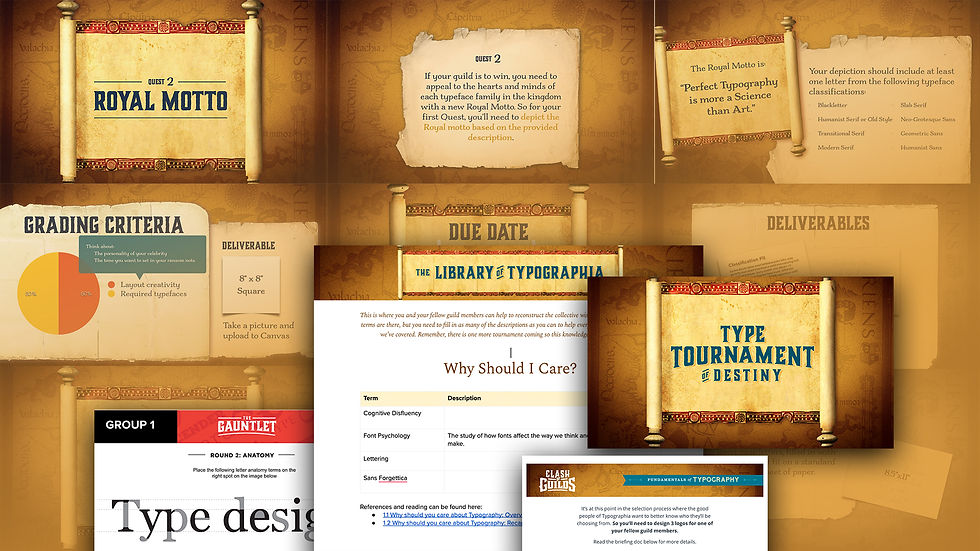


Administration
All that preparation and production have lead to this. Actually running the game. This looks awfully a lot like running your typical class with a few additions:
11
Keep track of points in a spreadsheet
I use a shared Google sheet as my leaderboard so students can see how they’re doing with leveling up and to instill a little friendly competition. Each XP earning task is shown and the spreadsheet is set up to do the math for me, with conditional color coding to automatically tell me when someone has leveled up.
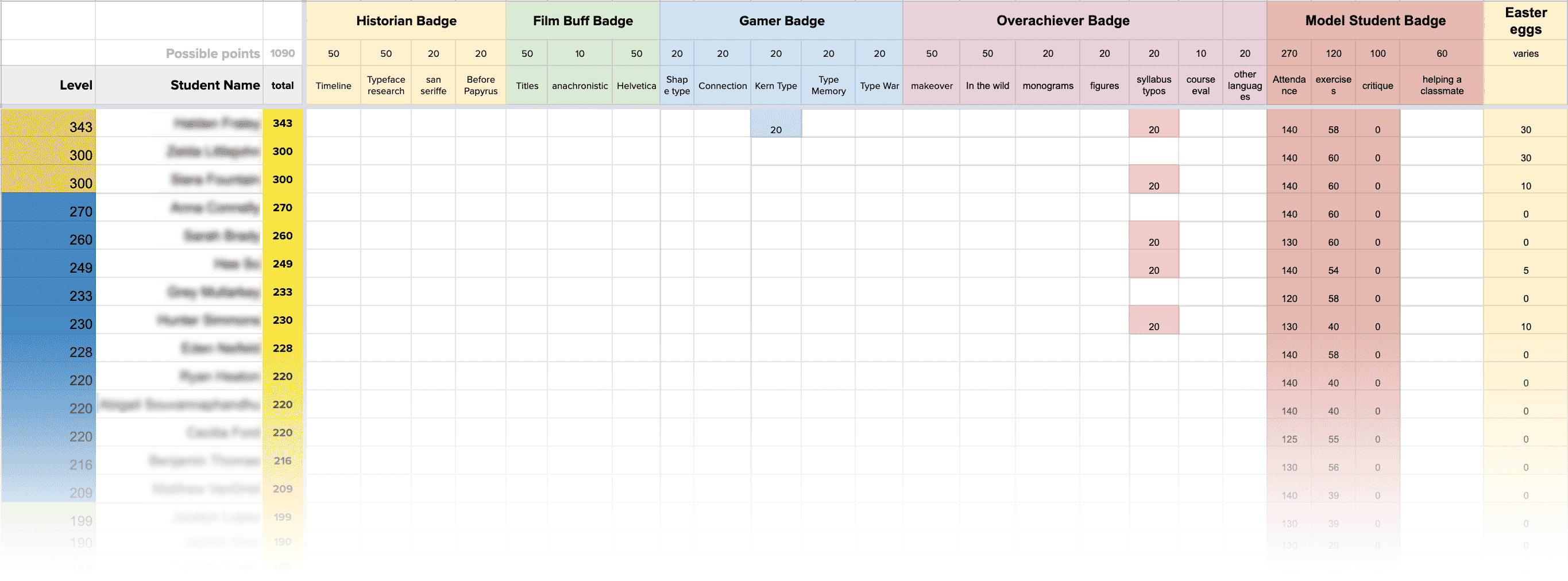
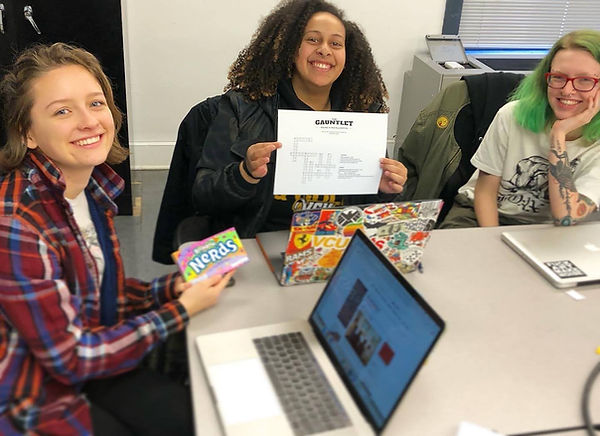
Inaugural winners of the Gauntlet Puzzle Tournament with their extravagant prize, a box of Nerds candy.
12
Celebrate moments
One of the most enjoyable parts of creating a gameful class is seeing students succeed while playing it. So have fun giving high-fives and cheers whenever a student wins a badge or levels up. It’s part community-building, part reinforcing the incentives.
13
Get feedback regularly
Even after running a gameful class for a few years, I’m still learning new things about how best to conduct this experiment. So make a habit of asking for feedback from students to see if your efforts are having the desired effect. Take notes after each activity and schedule periodic surveys throughout the semester. Like any aspect of teaching, there’s always room for improvement and not every class will react to the same methods in the same way.
Some feedback methods you could try:
-
PollEverywhere - anonymous surveys to gauge student attitudes and give them a feeling of having control over their learning environment
-
Your school’s Center for Teaching & Learning - msot schools have a department focussed on helping professors teach better. See if they can visit your class and conduct a focus group. You’ll need to leave the room so the students can speak freely and ask for a detailed anonymized report.
-
Peer review - Have a colleague, especially one familiar with the subject matter, visit your class. They’ll notice things you can’t while you’re preoccupied with actually teaching.
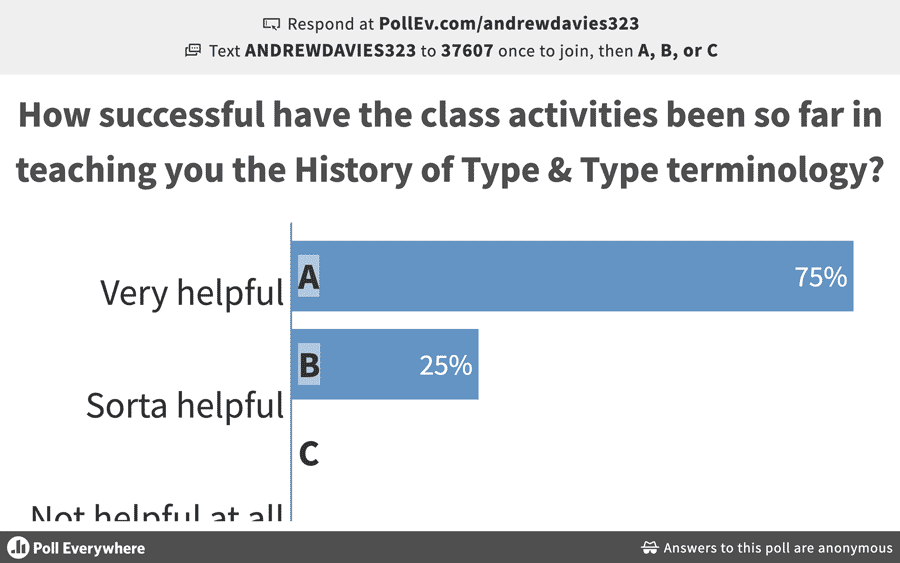
Keeping the surveys down to 2 or 3 questions and letting students to fill them out anonymously allows them to be honest with their feedback.
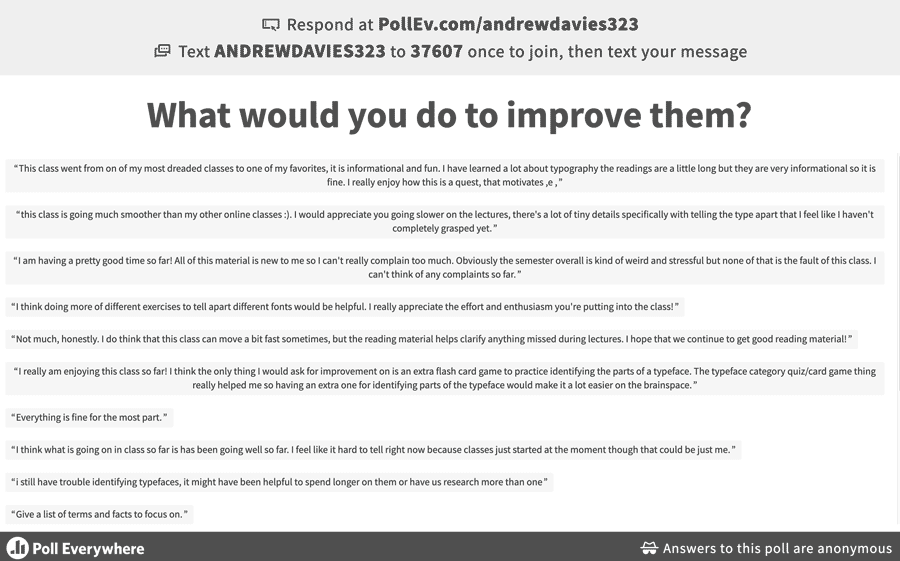
Resources
Software




A polling and survey platform that can Infuse interactivity into your remote lectures. One note of caution, I’ve had issues using it in Keynote presentations streamed through Zoom, so it seems to work best on Google slides or as a standalone service.
The “Google Trinity” ( Docs, Slides & Sheets)
From brainstorming ideas, to creating teaching materials, I’ve come to depend on these three apps for every aspect of my class setup, production and administration.
A great quiz game platform to create fun competitive quizzes based on your course material. This works in both in-person and remote classes.
Another quiz game platform that I've found works best for asynchronous assignments.
A jeopardy-style quiz game format for formative assessments and retrieval practice.
An easy-to-learn graphic design platform. If you’re not familiar with Adobe Illustrator or Photoshop, this is a great way to produce good looking class materials quickly.
Adobe’s answer to Canva. A quick intuitive way to create images, videos and landing pages. Although if your school doesn’t offer you an enterprise account there are a lot of limitations to the functionality so if you’re already knee-deep in the Adobe ecosystem this might be too restrictive to be worth it. If you were ever intimidated by their other software then this is a good way to introduce yourself to the Adobe-verse.
Reference Materials
Ditch that Textbook Digital Escape Room articles
These articles and templates helped walk me through the process of creating my own escape room for my class.
Berkeley’s Center for Teaching and Learning: Active Learning Strategies
This page gives a good overview of Active Learning techniques that can be easily inserted into any lecture. I’ve used plenty of these as starting points for activities in my class.
Rob Plevin’s “Active Learning Toolkit” and “Fun Teacher’s Toolkit”
More ideas for a variety of class activities ranging from quick refresher games to icebreakers.
eXPlore like a Pirate, Michael Matera
A fun guide to several structural gamification methods. Although meant for a k-12 setting, It provided the inspiration for my own adventures in gameful teaching.
The Gamification of Instruction and Learning FieldBook
This and the companion book The Gamification of Instruction and Learning, provided the theoretical backbone and motivation to start on this process for myself. If you’re looking into gameful teaching and wondering if it’s worth the effort, this will give you good reasons
why it is.



